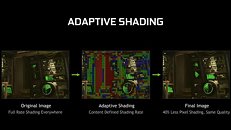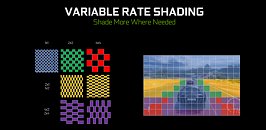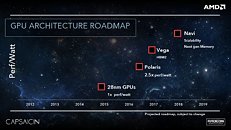Raevenlord
News Editor
- Joined
- Aug 12, 2016
- Messages
- 3,755 (1.25/day)
- Location
- Portugal
| System Name | The Ryzening |
|---|---|
| Processor | AMD Ryzen 9 5900X |
| Motherboard | MSI X570 MAG TOMAHAWK |
| Cooling | Lian Li Galahad 360mm AIO |
| Memory | 32 GB G.Skill Trident Z F4-3733 (4x 8 GB) |
| Video Card(s) | Gigabyte RTX 3070 Ti |
| Storage | Boot: Transcend MTE220S 2TB, Kintson A2000 1TB, Seagate Firewolf Pro 14 TB |
| Display(s) | Acer Nitro VG270UP (1440p 144 Hz IPS) |
| Case | Lian Li O11DX Dynamic White |
| Audio Device(s) | iFi Audio Zen DAC |
| Power Supply | Seasonic Focus+ 750 W |
| Mouse | Cooler Master Masterkeys Lite L |
| Keyboard | Cooler Master Masterkeys Lite L |
| Software | Windows 10 x64 |
While developers have become more and more focused on actually taking advantage of the PC platform's performance - and particularly graphical technologies - advantages over consoles, the truth remains that games are being optimized for the lowest common denominator first. Consoles also share a much more user-friendly approach to gaming - there's no need for hardware updates or software configuration, mostly - it's just a sit on the couch and leave it affair, which can't really be said for gaming PCs. And the console market, due to its needs for cheap hardware that still offers performance levels that can currently fill a 4K resolution screen, are the most important playground for companies to thrive. Enter AMD, with its almost 100% stake in the console market, and Variable Rate Shading.
As we've seen with NVIDIA's Turing implementation for Variable Rate Shading, this performance-enhancing technique works in two ways: motion adaptive shading and content adaptive shading. Motion adaptive shading basically takes input from previous frames in order to calculate which pixels are moving fast across the screen, such as with a racing perspective - fast-flying detail doesn't stay focused in our vision so much that we can discern a relative loss in shading detail, whilst stationary objects, such as the focused hypercar you're driving, are rendered in all their glory. Valuable compute time can be gained by rendering a coarse approximation of the pixels that should be in that place, and upscaling them as needed according to the relative speed they are moving across the frame. Content adaptive shading, on the other hand, analyzes detail across a scene, and by reducing shading work to be done across colors and detail that hasn't had much movement in the previous frame and frames - saves frame time.


This particular technology is one of those that makes all the sense for AMD to implement in their architecture, because these are sure ways of gaining performance and frametime levels with minimal compromises in image quality. This is a particularly important aspect in the svelte GPU world of consoles - yes, performance is extracted much closer to the metal, but remember, an Xbox One X is currently rendering full 4K games with a GPU that's much closer to an RX 580 in performance than to an RTX 2070 - a graphics card that can't run Anthem at the same 4K Medium settings that the Xbox console can (without RTX). NVIDIA themselves have said that in certain scenarios, the GTX 1660 Ti delivers 1.5x higher frame rates compared with the GTX 1060 - solely due to the application of VRS.

Not only in letting consoles achieve much higher pixel density does this tech work, but it can also allow for a performance democratization for VR, where higher frames per second are necessary to offset some side effects of that kind of gaming - and where Sony seems to be betting on as an evolutionary focus in the years to come. It remains to be seen whether or not AMD is able to implement this tech for Navi, but the upside is too great, and the patent too timely, for it not be deployed - at least in AMD's custom silicon for the next generation of consoles.
View at TechPowerUp Main Site
As we've seen with NVIDIA's Turing implementation for Variable Rate Shading, this performance-enhancing technique works in two ways: motion adaptive shading and content adaptive shading. Motion adaptive shading basically takes input from previous frames in order to calculate which pixels are moving fast across the screen, such as with a racing perspective - fast-flying detail doesn't stay focused in our vision so much that we can discern a relative loss in shading detail, whilst stationary objects, such as the focused hypercar you're driving, are rendered in all their glory. Valuable compute time can be gained by rendering a coarse approximation of the pixels that should be in that place, and upscaling them as needed according to the relative speed they are moving across the frame. Content adaptive shading, on the other hand, analyzes detail across a scene, and by reducing shading work to be done across colors and detail that hasn't had much movement in the previous frame and frames - saves frame time.


This particular technology is one of those that makes all the sense for AMD to implement in their architecture, because these are sure ways of gaining performance and frametime levels with minimal compromises in image quality. This is a particularly important aspect in the svelte GPU world of consoles - yes, performance is extracted much closer to the metal, but remember, an Xbox One X is currently rendering full 4K games with a GPU that's much closer to an RX 580 in performance than to an RTX 2070 - a graphics card that can't run Anthem at the same 4K Medium settings that the Xbox console can (without RTX). NVIDIA themselves have said that in certain scenarios, the GTX 1660 Ti delivers 1.5x higher frame rates compared with the GTX 1060 - solely due to the application of VRS.

Not only in letting consoles achieve much higher pixel density does this tech work, but it can also allow for a performance democratization for VR, where higher frames per second are necessary to offset some side effects of that kind of gaming - and where Sony seems to be betting on as an evolutionary focus in the years to come. It remains to be seen whether or not AMD is able to implement this tech for Navi, but the upside is too great, and the patent too timely, for it not be deployed - at least in AMD's custom silicon for the next generation of consoles.
View at TechPowerUp Main Site






